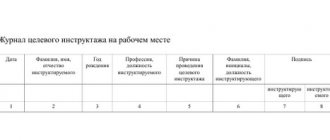Dear Colleagues! We are starting a series of publications on a topic that is important for every organization—labor safety briefings. The materials are primarily intended for university graduates and young occupational safety specialists, as well as those who want to refresh their knowledge.
This will be especially relevant, since already in 2021 the Russian Ministry of Labor plans to modernize the occupational safety management model. One of the changes that officials propose to introduce is to ensure personal participation of workers in ensuring safe working conditions in their workplaces. This will be spelled out in the new edition of Chapter 10 of the Labor Code. That is why the employer, during the required occupational safety briefings, is obliged to provide the staff with the maximum amount of necessary and useful information.
Goals and objectives of induction training
The obligation of all employers to familiarize their employees with labor protection (OHS) requirements is defined in Article 225 of the Labor Code of the Russian Federation. The purpose of the introductory briefing on labor protection is to familiarize the new employee with the existing ones in the organization:
- structure;
- labor regulations;
- equipment and production technology;
- features of the warehouse, territory and transport;
- fire safety measures;
- occupational health and safety instructions.
Obviously, in each organization all these points have their own characteristics and are not similar to similar ones operating in other companies. Such familiarization is mandatory for all newly hired persons. In each organization, all employees hired undergo induction training according to the induction instructions, they are introduced to the nuances and dangers of the new job. Violation of this legal requirement may result in a large fine.
The management of the organization should not confuse the concepts of “instruction” and “training” of employees. The legislation establishes clear rules regarding briefings. During this process, the instructor’s task is to convey to the employee the current rules and regulations. Whereas learning is a longer process that takes more than a few hours. In addition, employers provide training at their own discretion.
In addition to the introductory one, other briefings must be carried out at the workplace. ConsultantPlus experts analyzed the rules and requirements in detail. Use these instructions for free.
Who is holding it
The person who conducts the instruction is appointed by order of the head of the enterprise. It can be either a labor protection engineer or any other specialist of the enterprise. In the case of practical training at an educational institution, instruction is carried out by a teacher or training supervisor. There is also now a practice of transferring the functions of the labor protection department to third-party accredited organizations specializing in this service area.
At large enterprises that have their own fire and medical services, appropriate specialists are often involved in conducting training.
Who must be instructed
The list of persons who must receive instructions from the employer is given in paragraph 1 of clause 2.1.2 of the Training Procedure. These include, in particular:
- all citizens newly hired (even if the employee quit and then got a job again at the same company, he is still included in this list);
- all persons seconded to the company from other companies;
- specialists from third-party companies performing work in a designated area;
- students of educational institutions of appropriate levels undergoing practical training;
- all other persons who participate in production activities.
The employer has no right to allow persons to work who have not completed induction training.
Who can be exempt from introductory training on labor protection
No one can be exempted from mandatory induction training. This opportunity is provided only for initial training. Here, by order, the employer can exempt persons whose activities are not related to it:
- with operation;
- with service;
- with a test;
- with adjustment;
- with equipment repair;
- using tools (electrified, pneumatic, powder, carpentry, plumbing and others);
- with storage and use of raw materials and materials.
At the same time, the list of specific professions and positions exempted from this obligation is approved by a separate order. In other words, if you hire a specialist in the sales department, then he must be given introductory instructions on occupational safety, but he is allowed to refuse initial instruction directly at the workplace. The main thing is to issue an order about this in time.
Who is the instructor
Clause 7.13 of the Recommendations for organizing the work of the occupational safety service in an organization, approved by Resolution of the Ministry of Labor of Russia dated 02/08/2000 No. 14, indicates who conducts induction training on labor protection when hiring or transferring to another position. New employees are instructed by a special service or an occupational safety specialist, if there is one in the organization. Persons who have the right to instruct on occupational safety are established in clause 2.1.2 of the Procedure for training in labor protection and testing knowledge of labor protection requirements for employees of organizations, approved by the joint resolution of the Ministry of Labor and the Ministry of Education of the Russian Federation dated January 13, 2003 No. 1/29. These are, in particular:
- Head of the organization;
- OT specialist;
- an employee who is assigned these duties by order of the employer (or a person authorized by him).
The Russian Ministry of Labor, in letter No. 15-2/OOG-2884 dated 08/09/2016, indicated that even if the organization does not have an occupational safety specialist, the employer assigns responsibilities related to instructing workers on safety precautions and other rules to any person. The main condition is that he undergo training and testing of knowledge of occupational safety requirements in training organizations accredited in accordance with the order of the Ministry of Health and Social Development of Russia dated April 1, 2010 No. 205n.
If the director is the sole founder of the company and an employment contract has been concluded with him, he conducts induction training for himself, provided that there is no other employee authorized for this (letter of Rostrud dated April 27, 2017 No. PG/08346-03-3).
Instruction of new employees should be carried out in a separate occupational safety room or other specially equipped room. During the event, visual aids and other modern technical teaching aids should be used (clause 7.1.3 of GOST 12.0.004-90). Let's look at step by step how to conduct an introductory briefing on labor protection in an organization for a new employee:
- Approve the program.
- Identify responsible persons.
- Set a time and place for instruction.
- Give a lecture.
- Check how employees have understood the information.
- Write down the data in the journal and certify it with the signature of the person being instructed.
conclusions
Russian legislation obliges employers to conduct induction training on labor safety issues for their employees.
This procedure must be carried out by responsible persons authorized by the management of the organization.
Employed citizens must undergo this instruction immediately upon hiring. There are no exceptions for posted workers, as well as for those subjects who arrived at the enterprise to study or undergo practical training. In this case, the employee’s experience and education do not matter at all.
Timing and duration of instructing new employees
The employer is required to conduct induction training for a new employee on the day of his actual hiring. This follows from the explanations given by the Ministry of Labor in letter dated 05.05.2017 No. 15-2/OOG-1277. A candidate for a vacant position is not an employee, so there is no need to instruct him on occupational safety. Employers should also remember that, in addition to induction, the law provides for initial training in the workplace. It is carried out directly at the employee’s workplace after introductory instructions, but before admission to independent work.
The duration of the event must correspond to the program approved by the organization, which is developed on the basis of legislative and other regulatory legal acts of the Russian Federation, taking into account the specifics of the activity. Typically, the time it takes is from 4 hours to two working days (depending on production volumes).
When and how often is it carried out
Induction training is carried out once upon employment at the enterprise. Thus, a person who is transferred within the company to another position or returns from maternity leave does not have to take it again.
An employee who is transferred through dismissal is required to go through it again.
At large enterprises, instruction is also provided to employees of third-party organizations hired to perform any work on the organization’s territory.
You can learn more about this procedure from the following video:
Development and approval of the program
The organization independently develops and approves the 2021 occupational safety induction program; this occurs on the basis of legislative and other regulatory legal acts of the Russian Federation. The program takes into account the specifics of the organization's activities. An approximate list of questions for drawing up a program is contained in Appendix B to GOST 12.0.004-2015. The worker should be informed how to avoid hazards during the work process. For this purpose he is informed:
- about the specifics of the organization;
- work and rest schedule;
- rules of behavior in the workplace and in other areas of the organization;
- storage locations and procedure for using protective equipment;
- first aid procedures.
Taking into account the coronavirus pandemic in 2021, employers were required to instruct employees on measures to prevent coronavirus infection and what to do if there are signs of the disease.
It just seems that the instructions for conducting induction training are something complicated. In fact, this is simply a list of questions that are brought to the person being instructed, and the time allotted for their consideration. The sample program looks like this:
The sample shows that the instructions for conducting introductory training on labor protection are an appendix to the order. The form of the regulatory act on the approval of the program is not defined in any way. The employer usually approves such a program with an order, for example, this:
The order must be familiarized with the authorized person who is assigned the relevant responsibilities. Such a specialist puts a signature and date of review in the journal.
Induction log
After the employee is familiar with all occupational safety requirements, the inspector conducts an oral examination of the acquired knowledge and skills. After successfully answering the questions, the introductory safety briefing is considered complete, which should be recorded in a special logbook. Such a record contains the date of the event, the details of the person being instructed and the person instructing, and the division of the company where the employee is employed is indicated. Records must be certified with the signatures of the person being instructed and the person instructing (clause 2.1.3 of the Training Procedure). Another record that the employee has been properly instructed about safe working conditions must be included in his personal card (if the organization has one).
It should be noted that the forms of the registration log and personal card for completing occupational safety training are given in Appendix A to GOST 12.0.004-2015 (forms A.4 and A.2). They are not mandatory, but recommended, so each company approves convenient forms for itself. The log sheet for the introductory briefing on labor protection, compiled according to the recommended form, looks like this:
What documents need to be completed?
To conduct induction training in an organization, its management must ensure that the following documents are available:
- An order from the employer regulating the conduct of introductory training with each hired employee (meaning briefing on work safety issues).
- An order from the employer to grant a specific entity the authority to conduct training with each person hired by the organization.
- The training program, as well as the order for its approval at the enterprise.
- Instructions that detail the procedure for conducting induction training.
- A logbook that records information about a specific employee’s completion of introductory training. In this case, there must be an order from the employer approving the form of this journal.
In order to appoint a subject authorized to conduct instruction and approve the program with a logbook, the employer has the right to issue one general order, indicating the relevant decisions in separate paragraphs.
Making an order
As already mentioned, the employer can formalize all orders that relate to introductory training on labor safety issues either as separate orders or as one general act.
One way or another, the employer’s order must include the following information:
- Full name of the employing organization (optionally, individual entrepreneur).
- Title of the document (order) with serial number and date of publication.
- The name of the order itself, reflecting its essence.
- Links to regulatory documents governing induction training on labor safety issues. This could be, for example, the Labor Code of the Russian Federation and other acts of the Russian Federation.
- The contents of this order are the wording of all orders. The head of the organization must authorize a specific entity to conduct this training, as well as approve the required program and the corresponding logbook.
- Appoint a person who controls the implementation of this order (as a rule, the manager appoints himself).
- The decrypted signature of the director, as well as the introductory signature of the subject who received the authority to conduct training.
Sample order:
What programs and instructions should I use?
The program in accordance with which induction training is carried out at a specific enterprise may cover the following key areas:
- General information about the employing company.
- Key norms of the labor legislation of the Russian Federation concerning labor safety in the organization.
- Features of security and safety at this enterprise.
- Responsibilities and rules of conduct of an employee in the field of labor protection.
- Working conditions, presence of hazardous factors, preventive and protective measures.
- Sanitary requirements (standards) relating to work.
- Employee actions in case of accidents, assistance.
- Other significant issues.
Do I need a personal passage card?
A personal (personal) card, which records all the facts of training, can be issued at the enterprise for each individual employee. However, its use is not mandatory.
Such a card is maintained at the request of the employer - filling it out is recommended, but is not considered necessary.
Such cards are usually issued in fairly large organizations - with a large number of employees and a significant “turnover” of personnel (where all kinds of briefings are often carried out).
Filling out the log
The induction training ends at the enterprise with a knowledge test and entering the relevant data into the registration log.
Knowledge testing is always carried out based on the results of the lecture and is an oral test of the employee on the meaning of labor protection rules. All this is done by a subject who has received the appropriate authority from the employer.
The registration log, which is filled out at the enterprise, provides the following columns:
- Date of conducting (passing) the instruction procedure.
- Full name of the citizen who completed this training.
- Year of birth of the instructed subject.
- Position (position, profession) of the person being instructed.
- The name of the unit (department) in which the person being instructed will work.
- Full name and position (position) of the subject conducting the briefing.
- Instructor's signature.
- Signature of the person being instructed.
There is no strict template for this magazine. It must be stored at the enterprise for at least 10 years.
.









